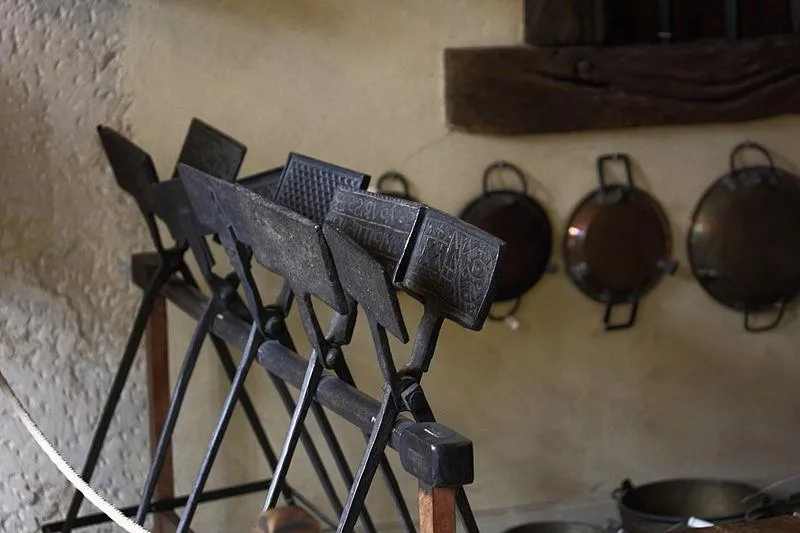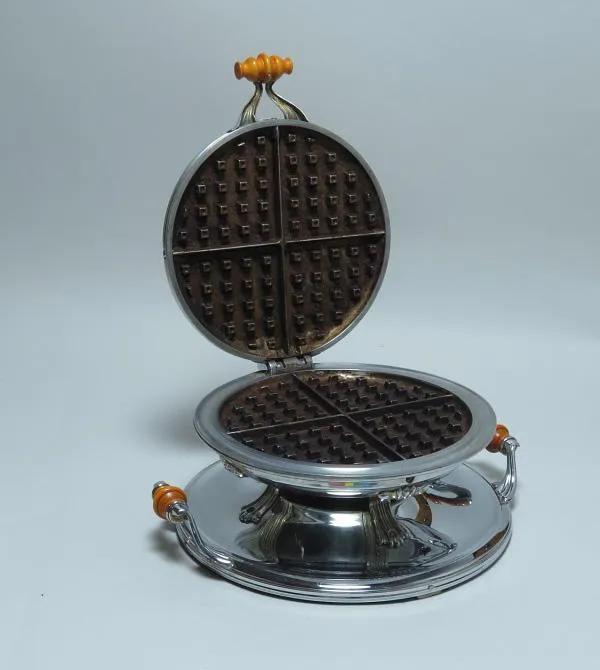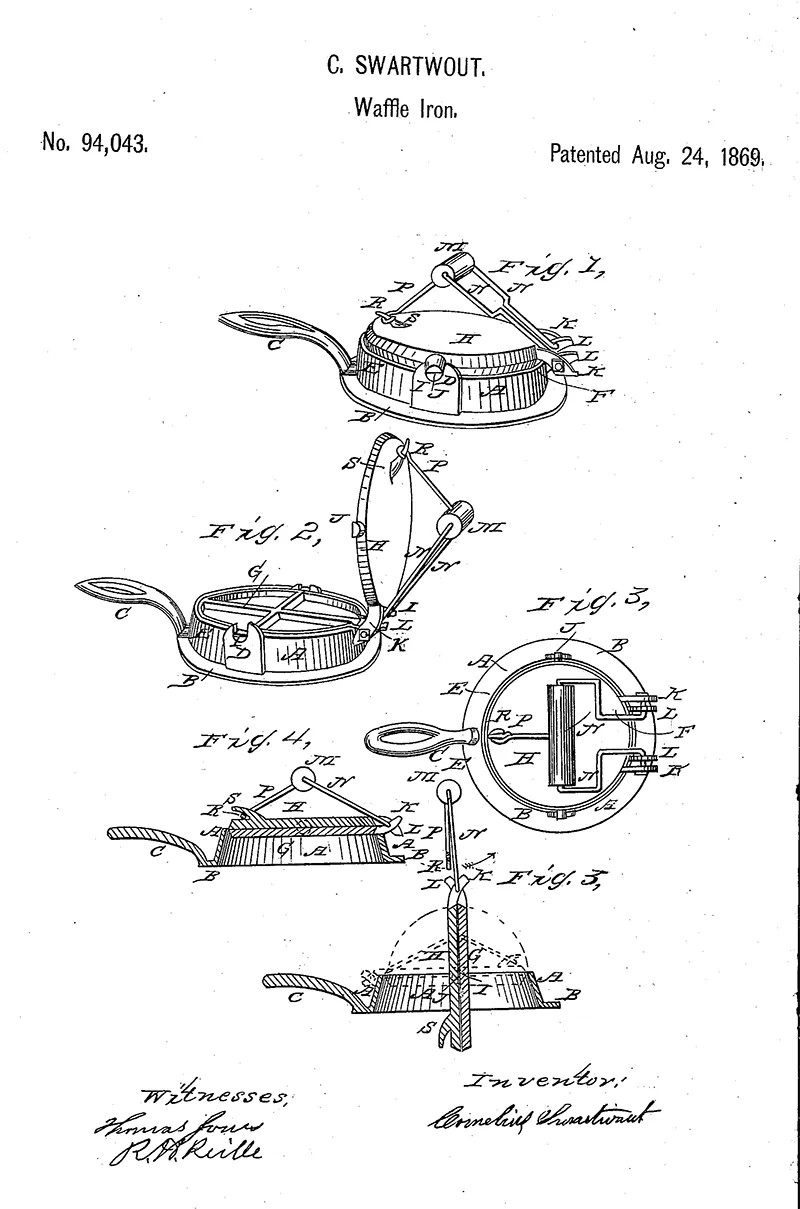A Brief History of the Waffle Iron
Cornelius Swartwout’s invention, patented more than 150 years ago, helped feed America’s passion for waffles
/https://tf-cmsv2-smithsonianmag-media.s3.amazonaws.com/filer/54/0b/540b5d2b-3171-4fd5-b545-dc7587b6c331/waffle_iron_illustration.jpg)
There’s no waffling about waffles: people love them! Covered in syrup, filled with fruit, piled high with ice cream or served with fried chicken, Americans love waffles. The Waffle House alone, founded in 1955, sells approximately 145 waffles every minute of every day at its 2,100 restaurants in 25 states.
Thank goodness for the waffle iron. The modern version of this ancient kitchen utensil was invented by Cornelius Swartwout more than 150 years ago. He created a stove-top version of the waffle iron that was easy to turn and less likely to burn the hand of the cook.
In fact, we celebrate Swartwout’s invention every August 24 on National Waffle Day, a commemoration that coincides with the date his patent was issued by the U.S. Patent and Trademark Office in 1869.

Waffle irons have been around for a long time. The ancient Greeks had a version that they used to make wafers similar to today’s waffles. Medieval Europeans also used them to cook early waffles. However, these devices mostly consisted of two iron plates with wooden handles. Users held them over an open fire or on the hearth and tried not to burn the waffles—or themselves.
Yve Colby, a museum technician at the Smithsonian’s National Museum of American History, researched the product for nearly two years while working on the Domestic Life Collection, which has at least 50 waffle irons dating back more than 300 years.

“It’s a complicated history,” Colby says. “Waffle irons date back a long way. Our collection includes wafer irons from the early 18th century to an electric waffle iron made in 1984.”
In the early days of waffle irons, the plates often included delicate designs, almost like etchings, that left imprints on the waffle. As time progressed, and people began to include tasty toppings, the waffle iron began to take on more of the grid shape we know today, which left gaps in the cooked product to hold syrup, fruit and other stomach-pleasing treats.
Trouble was, the old waffle irons were hard to handle. They were heavy and cumbersome, and the user often got burned. The wooden handles tended to get scorched, as did the waffle since it couldn’t really be checked to see if it was cooked.

That’s when Swartwout saved the day. He developed the first waffle iron that would sit easily on a wood stove and included a useful handle for opening, closing and turning the device without getting burned. Described as an “Improvement in Waffle-Irons,” his invention received U.S. Patent No. 94,043, which was assigned to himself, Joseph Foxell, Thomas Jones and Edward W. Millard, all of Troy, New York.
In the patent, Swartwout provided the following description:
“The nature of my invention consists in providing a handle, connected with and forming part of a waffle-iron, by means of which the same may be readily turned over without danger of slipping, and without the possibility of burning the hand.
It also consists in providing a device, by means of which the upper or covering portion of a waffle-iron may be raised, so as to expose the interior, for filling or for removing the waffle when done, without danger of the cover slipping back, and without burning the hand.”
Obviously, Swartwout wanted to minimize the chances of singeing the skin. The inventor’s ancestry was Dutch, which was one of the formative cultures in the 14th century that kicked off the early waffle craze. More than likely, he witnessed family members getting burned as they tried to cook waffles with the old iron plates.
Swartwout’s device became quite popular and spread quickly around the country. Websites today are loaded with antique waffle irons, dating from 1869 through the early 20th century, when electric models were first introduced. General Electric actually developed a prototype of the first electric waffle iron in 1911, but didn’t begin production until seven years later.
The waffle iron has been a source of gastronomic pleasure for multiple generations. From sweet and syrupy to sumptuous and savory, this invention has sated appetites for breakfast, lunch, dinner and even midnight snacks.

It was also responsible for another innovative concept that left an important footprint on modern culture: the athletic shoe. In 1972, University of Oregon track coach Bill Bowerman applied for a patent for a new kind of sports footwear that featured shaped rubber studs on the sole to provide better traction. The inventor used his wife’s waffle iron to create the patterned grips on the bottom of the shoe. Bowerman, who later founded Nike, was off and running.
“We actually have the original Nike Waffle Shoe on display at the National Museum of American History,” Colby says.
Visitors can ooh and aah over the trainers—part of the museum's "American Enterprise" exhibition. But, for this product, hold the syrup.
/https://tf-cmsv2-smithsonianmag-media.s3.amazonaws.com/accounts/headshot/dave.png)
/https://tf-cmsv2-smithsonianmag-media.s3.amazonaws.com/accounts/headshot/dave.png)